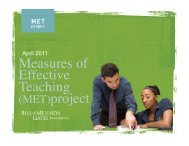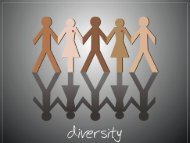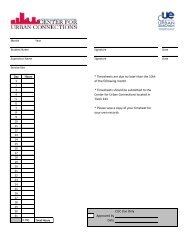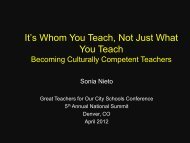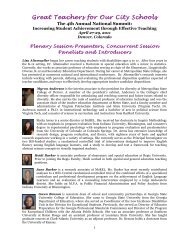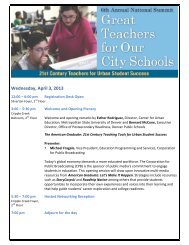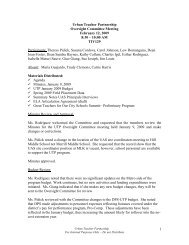Philip Trejo, Director, Office of Professional Development, Pueblo ...
Philip Trejo, Director, Office of Professional Development, Pueblo ...
Philip Trejo, Director, Office of Professional Development, Pueblo ...
Create successful ePaper yourself
Turn your PDF publications into a flip-book with our unique Google optimized e-Paper software.
Academic
Goals for my segment are:<br />
Get you excited about Academic Resiliency.<br />
Why it is so important for students and<br />
especially our Urban students.<br />
To provide a number <strong>of</strong> takeaway tools to get<br />
you started in making whatever supports you<br />
have in place for students much for effective.
Academic
Academic Resiliency<br />
Academic resilience refers to a<br />
student's willingness to persevere<br />
at academic tasks even when they<br />
are frustrated. In other words,<br />
academically resilient children do<br />
not give up, no matter what faces<br />
them.
Resilient students are:<br />
“students who succeed in<br />
school despite the presence<br />
<strong>of</strong> adverse conditions.”<br />
Waxman, H. C., Gray, J.P., & Padron, Y. N. (2003). Review <strong>of</strong><br />
Research on Educational Resilience (p.1). CA: Center for Research<br />
on Education, Diversity & Excellence.
An Example <strong>of</strong> Differences in<br />
Academic Resilience<br />
Let's say that 10-year-olds Roger and Tory have<br />
nearly identical math skill sets and intellectual<br />
aptitude. Roger, however, has high academic<br />
resilience while Tory has low academic<br />
resilience. When their teacher introduces a<br />
challenging new type <strong>of</strong> math problem, they<br />
probably both experience frustration and make<br />
similar errors. Due to his personality, though,<br />
Roger is much more likely than Tory to fight to<br />
master the new math skill.
ANDREW J. MARTIN AND HERBERT W.<br />
MARSH 4-C model<br />
confidence (self-efficacy)<br />
control<br />
composure (low anxiety)<br />
commitment (persistence)
Academic Resilience<br />
Academic Resiliency subsequently predicts three<br />
educational and psychological “outcomes”:<br />
Enjoyment <strong>of</strong> school<br />
Class participation<br />
And<br />
General self-esteem
Learning Objective 2<br />
Why it is so important for<br />
students and especially<br />
our Urban students.
• a nationwide study shows, the average high<br />
school graduation rate in the nation’s 50<br />
largest cities was 53 percent, compared with<br />
71 percent in the suburbs.<br />
• In Cleveland, only 38 percent <strong>of</strong> high school<br />
freshmen graduated within four years.<br />
• New York Times, Apr 22, 2009
Every school day, more than 7,200 students fall through<br />
the cracks <strong>of</strong> America's public high schools. Three out <strong>of</strong><br />
every 10 members <strong>of</strong> this year’s graduating class, 1.3<br />
million students in all, will fail to graduate with a diploma.<br />
The effects <strong>of</strong> this graduation crisis fall disproportionately<br />
on the nation’s most vulnerable youths and communities.<br />
A majority <strong>of</strong> non-graduates are members <strong>of</strong> historically<br />
disadvantaged minorities and other educationally<br />
underserved groups. They are more likely to attend<br />
school in large, urban districts. And they come<br />
disproportionately from communities challenged by<br />
severe poverty and economic hardship.<br />
Education Week Vol. 29, Issue 34, Pages 22-23, 30
Last year, Hispanic and African American high<br />
school graduates met ACT’s College Readiness<br />
Benchmarks in English, reading, mathematics,<br />
and science at substantially lower rates than did<br />
Asian and White graduates.<br />
For example, the rate <strong>of</strong> White graduates who were<br />
college ready in English (77%) was twice that <strong>of</strong><br />
their African American peers (35%). Hispanics were<br />
slightly lower.
On average, African-American and Latino high<br />
school seniors perform math and read at the<br />
same level as 13-year-old white students.<br />
The Education Trust says African-American and<br />
Latino students have made little to no progress<br />
in 12th-grade reading scores since 1994,<br />
continuing to lag behind white students. Math<br />
achievement has also remained flat, with the<br />
gap between white students and those <strong>of</strong> color<br />
widening.<br />
Huffington Post, March 23, 2013
• Black, Latino Students Perform at Levels <strong>of</strong> 30<br />
Years Ago<br />
• National Center for Education Statistics in<br />
2009 and 2011 showed that black and<br />
Hispanic students trailed their white peers by<br />
an average <strong>of</strong> more than 20 test-score points<br />
on the NAEP math and reading assessments at<br />
4th and 8th grades, a difference <strong>of</strong> about two<br />
grade levels.
• Only about half <strong>of</strong> Colorado’s high school<br />
students are pr<strong>of</strong>icient or above in writing and<br />
less than half <strong>of</strong> middle school and high school<br />
students are pr<strong>of</strong>icient or above in math. And,<br />
one <strong>of</strong> every four Colorado high school students<br />
fails to graduate in four years. These outcomes<br />
are much worse for economically disadvantaged<br />
and minority students who, on average, test less<br />
pr<strong>of</strong>icient across grade levels and subjects and<br />
have even lower graduation rates.
Boulder Valley School District on its<br />
achievement gap.<br />
• Reading: 70 percent <strong>of</strong> American Indian, 86 percent <strong>of</strong> Asian-<br />
American, 68 percent <strong>of</strong> African-American and 88 percent <strong>of</strong> white<br />
students scored partially pr<strong>of</strong>icient or better on the state<br />
standardized test. Latinos? 42 percent.<br />
• Writing, partially pr<strong>of</strong>icient or better: American Indian, 52 percent;<br />
Asian-American, 77 percent; African-American, 51 percent; white,<br />
76 percent. Latinos? 31 percent.<br />
• Math, partially pr<strong>of</strong>icient or better: American Indian, 54 percent;<br />
Asian-American, 80 percent; African-American, 47 percent; white,<br />
75 percent. Latinos? 33 percent.<br />
• Science, ditto: American Indian, 41 percent; Asian-American, 71<br />
percent; African-American, 39 percent; white, 72 percent. And<br />
Latinos? 24 percent.<br />
Denver Post, 2009
• In Colorado, whites get college degrees at<br />
three times the rate Latinos do and twice the<br />
rate <strong>of</strong> blacks. Colorado Public Radio<br />
1/23/2013
More <strong>of</strong> the same trap.
Supports<br />
- Study Skills<br />
- Math Skills<br />
- Reading Comprehension<br />
- Tutoring<br />
- Supplemental Instruction
The case for Academic Resiliency.<br />
HOW CHILDREN SUCCEED: Grit, Curiosity, and<br />
the Hidden Power <strong>of</strong> Character by PAUL TOUGH<br />
Mindset: The New Psychology <strong>of</strong> Success by<br />
Carol Dweck<br />
Choosing a GOOD Road by Jonathan Brennan
The case for Academic Resiliency.<br />
Marzano’s (Nine) High-Yield Instructional<br />
Strategies By Robert J. Marzano<br />
Student Academic Mindset Interventions by<br />
Jason Snipes, Cheri Fancsali, and Ginger Stoker<br />
2012<br />
Grit: Angela Duckworth
Now the simple to do but hard work.<br />
Learning Objective 3:<br />
To provide a number <strong>of</strong><br />
takeaway tools to get you<br />
started in making whatever<br />
supports you have in place for<br />
students much for effective.
So you are convinced, now what?<br />
Use the Continuous Quality<br />
Improvement Model (CQI) to drive<br />
your programing.<br />
In simplest terms; use the three<br />
driving questions<br />
and<br />
The Plan, Do, Study, Act/Reflect model.
The 3 questions<br />
What am I (are we) trying<br />
to accomplish?<br />
How will I (we) know a<br />
change is an improvement?<br />
What changes can I (we)<br />
make that will result in<br />
improvement?
Power points<br />
Evidence<br />
based or<br />
best<br />
practice<br />
Improve<br />
technique<br />
Standardize<br />
procedure<br />
Introduce<br />
new<br />
technology<br />
Simplify a<br />
process<br />
35
Measurement<br />
Maybe the most difficult for some is the how do<br />
we measure?<br />
Included are several examples that you may try<br />
and don’t be afraid to develop your own.<br />
Without measurement you can not determine<br />
program effectiveness, negative or positive<br />
impact and you have no grounds for creating<br />
program sustainability.
In closing<br />
I hope you have some level <strong>of</strong> excitement about<br />
Academic Resiliency (AR) and its potential to<br />
make a difference.<br />
You have a better idea <strong>of</strong> why AR is so<br />
important.<br />
You have some good materials to start with for<br />
incorporating a focus on AR into our student<br />
supports.



